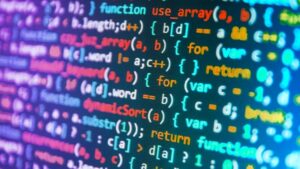Deprecated: mb_convert_encoding(): Handling HTML entities via mbstring is deprecated; use htmlspecialchars, htmlentities, or mb_encode_numericentity/mb_decode_numericentity instead in /var/www/vhosts/baboon-project.org/httpdocs/wp-content/plugins/skylinks/skylinks.php on line 38
Imagine a world where coding is as simple as dragging and dropping blocks. Welcome to the realm of block-based coding, a revolutionary approach that’s transforming the way we learn and understand programming. It’s a world where algorithms come to life through colourful, interlocking blocks, making coding accessible to everyone.
This isn’t just a child’s game, though. Block-based coding is proving to be a powerful tool in the hands of seasoned professionals too. From simplifying complex code to encouraging logical thinking, it’s reshaping the coding landscape.
Block Based Coding
The Concept of Visual Programming
 Visual programming, in essence, provides a graphical interface to construct programs. Instead of typing textual code in traditional programming, users manipulate program elements graphically. This method, often hinged on Block-Based Coding, gives programming a visual flow, making it more understandable and accessible. Furthermore, it aligns with the intuitive human propensity for recognizing patterns and shapes, enriching the learning experience. In fact, children as young as five can grasp the basics of programming concepts in this way, proving its utility.
Visual programming, in essence, provides a graphical interface to construct programs. Instead of typing textual code in traditional programming, users manipulate program elements graphically. This method, often hinged on Block-Based Coding, gives programming a visual flow, making it more understandable and accessible. Furthermore, it aligns with the intuitive human propensity for recognizing patterns and shapes, enriching the learning experience. In fact, children as young as five can grasp the basics of programming concepts in this way, proving its utility.
How Block Based Coding Works
Block-Based Coding simplifies coding by presenting commands as blocks. Users drag and drop these blocks to create a functioning program. Each block represents a specific function or command, such as moving a character in a game or changing the colour of a screen. Hence, programming becomes akin to piecing together a jigsaw puzzle.
Importantly, each block also features unique shape and colour coding. This differentiates commands, eliminates risk of syntax errors, and aids in fostering programming skills. Conventionally, these blocks arrange themselves into stacks or sequences, introducing programmers to the concept of workflow, process, and logical sequencing in coding. Block Based Coding, in practical application, serves as a stepping stone to understanding complex code structures, and undoubtedly, revolutionises the landscape of programming education.
The Rise of Block Based Coding
Driven by a surge in educational technology and a greater focus on equipping students with next-generation skills, block based coding garners ever-increasing attention. Technological advancements have primed block-based coding for ascent, offering a novel, intuitive approach to making programming more accessible for all.
Block Based Coding in Education
No longer considered as a niche skill, coding emerges as an essential tool in educational curricula worldwide. Block-based coding, in particular, has a significant role in reshaping the landscape of education. As an intuitive method of learning programming, it allows students of varying levels—even those as young as elementary school—to learn and engage with coding. This approach empowers students by offering a fun, interactive way to grasp basic coding concepts. Breaking traditional barriers of textbook learning, block-based coding stimulates creativity and fosters independent thinking among students.
For instance, Scratch—a block-based coding platform developed by MIT Media Labs—grows in popularity as an effective educational tool. Other examples are Snap!, Blockly, Alice, and Tynker—all lauded for their versatility in helping students grasp diverse programming concepts.
Benefits for Early Learners
 The benefits of block-based coding translate remarkably well to early learning. Young students experiencing coding for the first time find block-based coding less intimidating since it eliminates the hurdle of syntax—the often daunting use of specific symbols, characters, and commands. Instead, learners focus on the heart of programming—the development of logical thinking and problem-solving skills.
The benefits of block-based coding translate remarkably well to early learning. Young students experiencing coding for the first time find block-based coding less intimidating since it eliminates the hurdle of syntax—the often daunting use of specific symbols, characters, and commands. Instead, learners focus on the heart of programming—the development of logical thinking and problem-solving skills.
The Future of Block Based Coding
An array of marked shifts encompass block-based coding’s foreseeable future. Technological evolution continues to drive advancement in this arena. Remaining rooted in the practicality of applicable knowledge retains priority, concentrating on intrinsically motivating learning experiences that players can adapt to different life contexts.
Innovations and Developments
Futuristic innovations and developments don’t merely predict an encouraging trajectory for block-based coding; they certify it. Emerging technologies, notably Artificial Intelligence (AI) and Augmented Reality (AR), anticipate integration into block-based coding platforms. In the typical manner of LEGO Mindstorms, robotics imbues the intersection of play and innovation, stimulating hands-on engagement and active learning.